

 |
|
 | |
Here’s the classic Donald Duck of Tony Strobl
by Anders Berglund
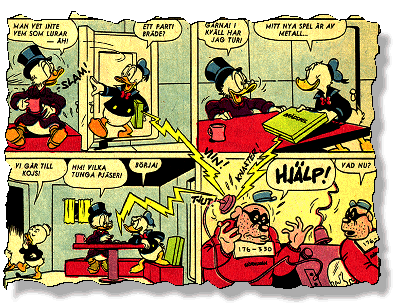
"Secret Of The Sargasso Sea" (Donald Duck 72). From the Swedish
edition published in 1961. © Walt Disney Prod.
DO YOU HAPPEN TO KNOW who drew the most pages of Disney comics over the years? A good guess would be Tony Strobl. If you were a reader of Donald Duck sometime between 1955 and the late 1970s you no doubt recognize his comics. His simple, clear style, restrained tempo and usually clever intrigue, made his comics appreciated by many. In short, his name is one of those that deserves to be brought out from behind the shadows of the giant trademark of Walt Disney.
 Anthony Joseph Strobl was born on 12 May 1915 in Cleveland, Ohio and was raised there by his Czechoslovakian parents. He acquired a solid general arts education at the Cleveland School of Art, between 1933 and 1937. A curious fact of comic book history is that he went there at the same time as Jerry Siegel and Joe Shuster. They had an idea about a new type of comic book hero and were just in the process of developing it. Tony assisted in fine-tuning the character technically, but he didn't think that it would have any great future. The character was Superman.
Anthony Joseph Strobl was born on 12 May 1915 in Cleveland, Ohio and was raised there by his Czechoslovakian parents. He acquired a solid general arts education at the Cleveland School of Art, between 1933 and 1937. A curious fact of comic book history is that he went there at the same time as Jerry Siegel and Joe Shuster. They had an idea about a new type of comic book hero and were just in the process of developing it. Tony assisted in fine-tuning the character technically, but he didn't think that it would have any great future. The character was Superman. By the time Tony had completed his degree, the first animated feature film, "Snow White and the Seven Dwarfs", had just had its premier. Tony saw it and, of course, thought that drawing dwarfs and cute animals could be something for him, so he sent off his application to the Disney studio. They were not so convinced, rejecting him after three months with the motivation that he needed to have a degree from an art school! Some time later, when he arrived in Hollywood and personally visited the studio's personnel office, he was accepted with the same portfolio and no questions about the art school credentials he in fact had.
By the time Tony had completed his degree, the first animated feature film, "Snow White and the Seven Dwarfs", had just had its premier. Tony saw it and, of course, thought that drawing dwarfs and cute animals could be something for him, so he sent off his application to the Disney studio. They were not so convinced, rejecting him after three months with the motivation that he needed to have a degree from an art school! Some time later, when he arrived in Hollywood and personally visited the studio's personnel office, he was accepted with the same portfolio and no questions about the art school credentials he in fact had.
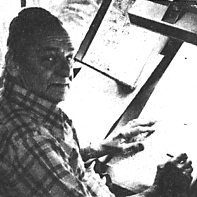 |
Tony Strobl, photographed by Klaus Strzyz, from his and Andreas C. Knigge's book "Disney von Innen" (Berlin 1988) ISBN 3-548-36551-5. |
 In December 1938 he began his first assignment: the cupids for the Pastoral Symphony sequence in Fantasia. His job was that of "in-betweener", in other words, he drew all of the in-between frames that were needed in order for the animator's more scarce drawings to come to life. Commenting later about all of those cupids, "When everything was finished I counted them; since there were as many as 18 or 20 flying around at the same time, there were altogether about 77,000!" After this he worked on Dumbo and Pinocchio, among other things, before being drafted into the army when WW II broke out.
In December 1938 he began his first assignment: the cupids for the Pastoral Symphony sequence in Fantasia. His job was that of "in-betweener", in other words, he drew all of the in-between frames that were needed in order for the animator's more scarce drawings to come to life. Commenting later about all of those cupids, "When everything was finished I counted them; since there were as many as 18 or 20 flying around at the same time, there were altogether about 77,000!" After this he worked on Dumbo and Pinocchio, among other things, before being drafted into the army when WW II broke out. Once back in civilian life he decided not to return to film. Instead, he had his sights set on the comics industry, being especially lured by the higher salaries that illustrators were paid. For a couple years he had a whole bunch of small illustration jobs before walking into the offices of Western Publishing in Beverly Hills in 1947, where he sought employment and was hired. Western Publishing put out most of the funny animal comics using figures from film studios like Disney, Warner Brothers (Bugs Bunny & Co.) and Walter Lantz (Woody Woodpecker). As a result, Tony and other illustrators who wanted to, were able to work with a broad spectrum of characters. His first comic at Western was entitled Bucky Bug and was published in January 1949 in issue number 100 of Walt Disney's Comics and Stories.
Once back in civilian life he decided not to return to film. Instead, he had his sights set on the comics industry, being especially lured by the higher salaries that illustrators were paid. For a couple years he had a whole bunch of small illustration jobs before walking into the offices of Western Publishing in Beverly Hills in 1947, where he sought employment and was hired. Western Publishing put out most of the funny animal comics using figures from film studios like Disney, Warner Brothers (Bugs Bunny & Co.) and Walter Lantz (Woody Woodpecker). As a result, Tony and other illustrators who wanted to, were able to work with a broad spectrum of characters. His first comic at Western was entitled Bucky Bug and was published in January 1949 in issue number 100 of Walt Disney's Comics and Stories. In the early fifties, production of Disney's popular comics increased. By 1952, Walt Disney's Comics and Stories had a circulation of almost 4 million per issue, a figure which has never been surpassed by any other comic. As a result, Western Publishing made the sporadically released titles Donald Duck, Mickey Mouse and Uncle Scrooge into regular bi-monthly publications. The publishing house's foremost duck artist, Carl Barks, took it upon himself to supply the Uncle Scrooge magazine with material, as well as a monthly ten page feature for Walt Disney's Comics and Stories. The rest of the gang had to fill the pages of Donald Duck: Jack Bradbury - with his characteistic fine-line shadowing; Phil de Lara - with childishly happy characters; Dick Moores - with short, round ducks; Paul Murry - see other article; and, of course, Tony Strobl. After 1954, it was Strobl who was responsible for a majority of the content in Donald Duck, while Murry and Bradbury concentrated on Mickey Mouse.
In the early fifties, production of Disney's popular comics increased. By 1952, Walt Disney's Comics and Stories had a circulation of almost 4 million per issue, a figure which has never been surpassed by any other comic. As a result, Western Publishing made the sporadically released titles Donald Duck, Mickey Mouse and Uncle Scrooge into regular bi-monthly publications. The publishing house's foremost duck artist, Carl Barks, took it upon himself to supply the Uncle Scrooge magazine with material, as well as a monthly ten page feature for Walt Disney's Comics and Stories. The rest of the gang had to fill the pages of Donald Duck: Jack Bradbury - with his characteistic fine-line shadowing; Phil de Lara - with childishly happy characters; Dick Moores - with short, round ducks; Paul Murry - see other article; and, of course, Tony Strobl. After 1954, it was Strobl who was responsible for a majority of the content in Donald Duck, while Murry and Bradbury concentrated on Mickey Mouse. |
Barks | |||||
 |
Early Barks |  |
Murry | |||
 |
Bradbury |  |
Moores |  | ||
 |
de Lara | Taliaferro |

In the mid 1960s, Tony was contacted by the people at the Disney studios, this time regarding work as a comic artist on a freelance basis. They had started to produce comics for magazines, but only for outside of the United States (Western Publishing had the license for the US market). He said yes at once, especially since Disney was paying $30 per page compared to the $23 he was making. Strobl continued working for Western Publishing, but increasingly less so. And from the mid seventies he no longer did comics books, only coloring books, puzzles and so forth.
"In self defence, I write an occasional story ..."
During his first years at Western, Strobl also did the inking and lettering of the serials that he drew. The problem was that he was so extremely slow doing that sort of work - "an eight page story would take me two weeks to do, working seven days a week!". So, since the middle of the fifties, he has limited himself to the actual pencil drawing. For the same reason, he has forgone, for the most part, writing the story line for the comics. Since that was not his strong suit, it made better economic sense to stick to the drawing. Through the years, most of the inking has been done by two people: Steve Steere and John Liggera.
 His final work as a Disney artist came during 1986-87, doing a daily Donald Duck strip, as well as doing a Sunday strip for a short time during 1987. When I had the pleasure of meeting him in June 1987 at his home in Northridge, just outside of Hollywood, he had just been laid off. This irritated him greatly. As a freelancer, he had always had a very loose relationship with the studio, and this meant that he didn't have a pension. His very last comics job was as the manuscript writer for the newly started Duck Tales series, 1987-89. Tony Strobl died in 1991.
His final work as a Disney artist came during 1986-87, doing a daily Donald Duck strip, as well as doing a Sunday strip for a short time during 1987. When I had the pleasure of meeting him in June 1987 at his home in Northridge, just outside of Hollywood, he had just been laid off. This irritated him greatly. As a freelancer, he had always had a very loose relationship with the studio, and this meant that he didn't have a pension. His very last comics job was as the manuscript writer for the newly started Duck Tales series, 1987-89. Tony Strobl died in 1991.
 In regards to the manuscripts, it was common that they were written by others than the artists themselves, with the main exception being Carl Barks. These scripts, however, could be very different both in style and detail; everything from typewritten texts to detailed picture synopses with sketches on an individual frame level. It goes without saying then, that there is a large gray area regarding who should get the credit for having created a certain comic. The same script would no doubt give a completely different impression if it was worked by two different artists, even with the exact same wording. A certain parallel can be drawn here to an author vs. a director in a theater production.
In regards to the manuscripts, it was common that they were written by others than the artists themselves, with the main exception being Carl Barks. These scripts, however, could be very different both in style and detail; everything from typewritten texts to detailed picture synopses with sketches on an individual frame level. It goes without saying then, that there is a large gray area regarding who should get the credit for having created a certain comic. The same script would no doubt give a completely different impression if it was worked by two different artists, even with the exact same wording. A certain parallel can be drawn here to an author vs. a director in a theater production.
 During later years, however, Strobl did write stories himself:
During later years, however, Strobl did write stories himself:
 "Certain comic book writers present problems," Strobl told me in a letter in 1982. "They themselves are not artists and cannot conceive a layout of a panel and dialogue. They get so 'wordy'. Three or four characters speaking in one panel plus 6 or 8 characters milling about. They rarely have enough room for drawing. So, in self defence, I write an occasional story with a minimum of dialogue + lots of room for drawing."
"Certain comic book writers present problems," Strobl told me in a letter in 1982. "They themselves are not artists and cannot conceive a layout of a panel and dialogue. They get so 'wordy'. Three or four characters speaking in one panel plus 6 or 8 characters milling about. They rarely have enough room for drawing. So, in self defence, I write an occasional story with a minimum of dialogue + lots of room for drawing."
 Until the 1960s, Carl Fallberg, Bob Gregory and Vic Lockman were the main authors of Strobl's comics.
Until the 1960s, Carl Fallberg, Bob Gregory and Vic Lockman were the main authors of Strobl's comics.
 Strobl would start his work by sketching the layout of the pages on standard sized paper if this was not already done in the script. Then he would start drawing frame by frame, on the light table, in double scale, finally redrawing and combining the frames onto a completed page of transparent paper. At his very fastest, he managed to complete 35-40 frames per day, or 4-5 pages.
Strobl would start his work by sketching the layout of the pages on standard sized paper if this was not already done in the script. Then he would start drawing frame by frame, on the light table, in double scale, finally redrawing and combining the frames onto a completed page of transparent paper. At his very fastest, he managed to complete 35-40 frames per day, or 4-5 pages.
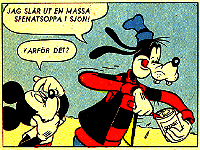 |
Mickey and Goofy à la Strobl. © Walt Disney Prod. |

Strobl drew all sorts of comics, not just ducks, but despite the fact that he drew Mickey Mouse "umpteen times" he never really got used to him. On the other hand, he enjoyed drawing Bugs Bunny, as he did several other Warner figures:
Slow paced slapstick
Strobl's drawing style is characterized by its clean, even and harmonious lines, with a tendency towards the static. Sometimes this is what gives it an extra flair, stoically calm figures in the midst of chaotic events. This comic dimension is utilized especially with Cousin Fethry in the strips from the early 1970s. Another trademark are the extremely square-jawed dog people among the supporting characters.
 "I always liked Bugs - a slim figure, elegant, easy to draw, whereas I had more trouble with Porky Pig and Petunia. Then there were Elmer [Fudd] and Daffy Duck, a really wild character that you can do a lot with."
"I always liked Bugs - a slim figure, elegant, easy to draw, whereas I had more trouble with Porky Pig and Petunia. Then there were Elmer [Fudd] and Daffy Duck, a really wild character that you can do a lot with."
 A typical Strobl from the mid 1950s is "The Song Writers" (Donald Duck 38) - a twelve page comic written and inked by Strobl. Here the ducks have noticeably round forms, but are still well proportioned. Other early, typical Strobl works include "The Mysterious Crewless Ship" (Donald Duck 47) and "Mutilated Music" (Donald Duck 53), the comic where the nephews drive Donald crazy by digging Melvis Pressbe. Both are inked by John Liggera.
A typical Strobl from the mid 1950s is "The Song Writers" (Donald Duck 38) - a twelve page comic written and inked by Strobl. Here the ducks have noticeably round forms, but are still well proportioned. Other early, typical Strobl works include "The Mysterious Crewless Ship" (Donald Duck 47) and "Mutilated Music" (Donald Duck 53), the comic where the nephews drive Donald crazy by digging Melvis Pressbe. Both are inked by John Liggera.
 The stories also have common elements which, in the absence of detailed knowledge about the scriptwriters, I shall take the liberty of calling typically Strobl. By this I mean the element of absurdity in everyday life that courses through his comics, and throughout his years. The tone is delightfully trivial. The kids are constantly making sarcastic remarks about their overambitious uncle's goings on. This is, of course, a classic Donald vs. the nephews theme, but it is especially evident in many of Strobl's comics. A number of small incidents often add up to a rather spectacular chaotic whole. One might call it slapstick, but at a very slow pace.
The stories also have common elements which, in the absence of detailed knowledge about the scriptwriters, I shall take the liberty of calling typically Strobl. By this I mean the element of absurdity in everyday life that courses through his comics, and throughout his years. The tone is delightfully trivial. The kids are constantly making sarcastic remarks about their overambitious uncle's goings on. This is, of course, a classic Donald vs. the nephews theme, but it is especially evident in many of Strobl's comics. A number of small incidents often add up to a rather spectacular chaotic whole. One might call it slapstick, but at a very slow pace.
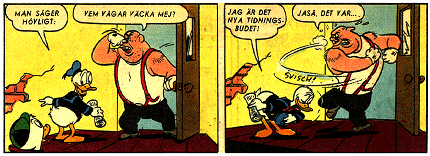
 A prime example is "The Paper Route Panic" (Donald Duck 66), also inked by Liggera. The main story is simple: Donald is supposed to take care of the nephews' paper route while they are at a Junior Woodchucks camp. He, of course, severely mismanages the task, completely engrossed as he is by inventions. In an effort to make amends, he volunteers to take the district nobody wants - "Drearybog Lane" - and with typical foolhardiness thinks that with a little simple politeness and helpfulness, he will turn it into a desirable neighborhood. And he truly believes what he says, "Now then children, we have done a good day's work!", after finishing their route the first day, all while the whole neighborhood is going up in fire and the subscribers are thrashing each other. What is so elegant about the comic is the fact that all of this chaos is built up in fully believable increments, and that at every step it is quite possible that Donald truly doesn't have a clue about what he is causing to happen.
A prime example is "The Paper Route Panic" (Donald Duck 66), also inked by Liggera. The main story is simple: Donald is supposed to take care of the nephews' paper route while they are at a Junior Woodchucks camp. He, of course, severely mismanages the task, completely engrossed as he is by inventions. In an effort to make amends, he volunteers to take the district nobody wants - "Drearybog Lane" - and with typical foolhardiness thinks that with a little simple politeness and helpfulness, he will turn it into a desirable neighborhood. And he truly believes what he says, "Now then children, we have done a good day's work!", after finishing their route the first day, all while the whole neighborhood is going up in fire and the subscribers are thrashing each other. What is so elegant about the comic is the fact that all of this chaos is built up in fully believable increments, and that at every step it is quite possible that Donald truly doesn't have a clue about what he is causing to happen. It is at this time, 1959, that Bob Gregory steps in as the scriptwriter. The Paper Route Panic was his second in the Donald Duck suite. Myself, I think that it is during the scant two years that he was writing that the strips are at their very best, and therefore Gregory should be given a good portion of the credit. Once again I must tackle that question of who should have the credit. In several interviews with Strobl, it became clear that he did not have any special recollection of "his" comics. He even had difficulty determining if it was he who had drawn a certain comic. This is, of course, a sign that perhaps it was not Strobl's contributions only - or even his contributions primarily - that made them memorable. But since comic strips are a symbiosis of text and image, it is probably not right to take away too much of the creative honor from him either. One can, at the very least, say that as a capable illustrator he made sure that he did justice to the script. It is also possible that the author adapted his scripts to the style of the illustrator which, given the fact that most of them stayed in the field for rather many years, would seem plausible. This would also explain how one can speak of a "Strobl style" in the stories despite there being many different authors.
It is at this time, 1959, that Bob Gregory steps in as the scriptwriter. The Paper Route Panic was his second in the Donald Duck suite. Myself, I think that it is during the scant two years that he was writing that the strips are at their very best, and therefore Gregory should be given a good portion of the credit. Once again I must tackle that question of who should have the credit. In several interviews with Strobl, it became clear that he did not have any special recollection of "his" comics. He even had difficulty determining if it was he who had drawn a certain comic. This is, of course, a sign that perhaps it was not Strobl's contributions only - or even his contributions primarily - that made them memorable. But since comic strips are a symbiosis of text and image, it is probably not right to take away too much of the creative honor from him either. One can, at the very least, say that as a capable illustrator he made sure that he did justice to the script. It is also possible that the author adapted his scripts to the style of the illustrator which, given the fact that most of them stayed in the field for rather many years, would seem plausible. This would also explain how one can speak of a "Strobl style" in the stories despite there being many different authors.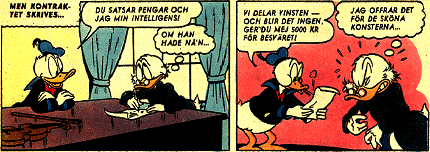
From "Donald Duck in the Fabulous Fiddlesticks" (Donald Duck 68).
 Anyhow, back to the "golden age" where we left off. It began with Donald Duck issue number 65 and the series "One for the Whammy", where we make the acquaintance of Scottish cousin Wee Angus from Scrooge's birthplace Cheapside in Scotland. We experience an exciting pentathlon, with branches for pole jumping, tiddlywinks, and house of cards construction.
Anyhow, back to the "golden age" where we left off. It began with Donald Duck issue number 65 and the series "One for the Whammy", where we make the acquaintance of Scottish cousin Wee Angus from Scrooge's birthplace Cheapside in Scotland. We experience an exciting pentathlon, with branches for pole jumping, tiddlywinks, and house of cards construction. "Stone Money Mystery" in Donald Duck number 69 is pretty good too, but mostly I mention that one for personal nostalgic reasons. The enormous stone coins from the Island of Yap in the Pacific Ocean, which played a central role in the story, fascinated me endlessly when I was a little tot. At the time, I had no idea that there actually existed such colossuses in reality! It is inked by Steve Steere who came to be the main Strobl inker. He inked a little more coarsely and less elegantly than did Liggera who, in my opinion, is the better of the two.
"Stone Money Mystery" in Donald Duck number 69 is pretty good too, but mostly I mention that one for personal nostalgic reasons. The enormous stone coins from the Island of Yap in the Pacific Ocean, which played a central role in the story, fascinated me endlessly when I was a little tot. At the time, I had no idea that there actually existed such colossuses in reality! It is inked by Steve Steere who came to be the main Strobl inker. He inked a little more coarsely and less elegantly than did Liggera who, in my opinion, is the better of the two. A third adventure worth mentioning is "Donald Duck in the Fabulous Fiddlesticks" (Donald Duck 68). In it we follow the search for the mystery of the secret behind the famous Pastradi violins' unique sound. The special wood they were made from happens to be extinct, but the ducks figure out that there is some preserved in a bridge in Venice. After a whole sequence of events, Scrooge buys the bridge and...well, for those uninitiated to Strobl's Duckburg world, it may seem a little strange that the whole thing actually ends with the unique pieces of wood being sold as toothpicks, but not for the rest of us.
A third adventure worth mentioning is "Donald Duck in the Fabulous Fiddlesticks" (Donald Duck 68). In it we follow the search for the mystery of the secret behind the famous Pastradi violins' unique sound. The special wood they were made from happens to be extinct, but the ducks figure out that there is some preserved in a bridge in Venice. After a whole sequence of events, Scrooge buys the bridge and...well, for those uninitiated to Strobl's Duckburg world, it may seem a little strange that the whole thing actually ends with the unique pieces of wood being sold as toothpicks, but not for the rest of us. I've saved my favorite for last. It's called "Riverboat Shuffle" (Donald Duck 73) and involves the kids and how they manage to win a bet by transporting passengers down the McKoozie River without any of them complaining. The plot may seem plain, but in actuality the passengers on this trip had to pull the stuck paddle wheeler free from a marsh, take a shortcut over land draging along half a restaurant kitchen, all to finally end up capsizing after a trip down a flume. Passengers can be unusually patient, but in this instance, there was the stipulation that, "every passenger who has just cause to complain about the boat trip has the right for a refund of their ticket money." A challenge to say the least. Nor had anybody ever paid for a ticket since the regulation was enacted, except for once in 1894, when a passenger had the misfortune of spraining his hand and was therefore unable to turn in his written complaint. How did they do it? Well, read the comic and find out!
I've saved my favorite for last. It's called "Riverboat Shuffle" (Donald Duck 73) and involves the kids and how they manage to win a bet by transporting passengers down the McKoozie River without any of them complaining. The plot may seem plain, but in actuality the passengers on this trip had to pull the stuck paddle wheeler free from a marsh, take a shortcut over land draging along half a restaurant kitchen, all to finally end up capsizing after a trip down a flume. Passengers can be unusually patient, but in this instance, there was the stipulation that, "every passenger who has just cause to complain about the boat trip has the right for a refund of their ticket money." A challenge to say the least. Nor had anybody ever paid for a ticket since the regulation was enacted, except for once in 1894, when a passenger had the misfortune of spraining his hand and was therefore unable to turn in his written complaint. How did they do it? Well, read the comic and find out!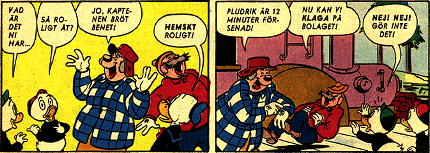
From "Riverboat Shuffle" (Donald Duck 73). © Walt Disney Prod.
 Towards the end of the sixties, Strobl's duck comics had increasingly to support the Donald Duck magazine, as Barks' production gradually ceased after his retirement. For a while, the serials contained Strobl ducks and Murry mice almost exclusively. The penmanship became coarser, but it still stood up well to the competition. Most of the stories continued to deal with everyday situations at home, using trivial, basic themes. A new theme arose around Cousin Fethry, however, coming in as a new chaotic element in the mid 1960s, first in a wild version drawn by Al Hubbard, but soon incorporated as a regular character in Strobl's Duckburg as well. These comics have Donald and Scrooge as Fethry's rivals, and the stories are built around misunderstandings among the three. There is an unusual emphasis on what the characters are thinking, while dialogue is more restrained.
Towards the end of the sixties, Strobl's duck comics had increasingly to support the Donald Duck magazine, as Barks' production gradually ceased after his retirement. For a while, the serials contained Strobl ducks and Murry mice almost exclusively. The penmanship became coarser, but it still stood up well to the competition. Most of the stories continued to deal with everyday situations at home, using trivial, basic themes. A new theme arose around Cousin Fethry, however, coming in as a new chaotic element in the mid 1960s, first in a wild version drawn by Al Hubbard, but soon incorporated as a regular character in Strobl's Duckburg as well. These comics have Donald and Scrooge as Fethry's rivals, and the stories are built around misunderstandings among the three. There is an unusual emphasis on what the characters are thinking, while dialogue is more restrained. During the latter half of the seventies, Strobl's duck comics disappeared from the Donald Duck magazine, being replaced by rather mediocre, European produced items. Strobl's comics continued to be sporadically published in a few other editions. Tony Strobl's exit marked the end of a generation of illustrators who used their experience at the Disney animation studios to go on and form their own styles. Their work might not rank among the most indispensable, even within the comics genre, but they were craftsmen with good technical skills and they helped to place the concept of "Donald Duck" in the open minds of those who were born in the fifties and sixties. For that they deserve praise.
During the latter half of the seventies, Strobl's duck comics disappeared from the Donald Duck magazine, being replaced by rather mediocre, European produced items. Strobl's comics continued to be sporadically published in a few other editions. Tony Strobl's exit marked the end of a generation of illustrators who used their experience at the Disney animation studios to go on and form their own styles. Their work might not rank among the most indispensable, even within the comics genre, but they were craftsmen with good technical skills and they helped to place the concept of "Donald Duck" in the open minds of those who were born in the fifties and sixties. For that they deserve praise.
References:
![]() "Tony Strobl" by Anders Berglund, NAFS(K)uriren 10, June 1983.
"Tony Strobl" by Anders Berglund, NAFS(K)uriren 10, June 1983.
![]() "Ner med Barks-plankarna" by Karl-Erik Lindkvist, NAFS(K)uriren 11, Septober 1984.
"Ner med Barks-plankarna" by Karl-Erik Lindkvist, NAFS(K)uriren 11, Septober 1984.
![]() Interview with Tony Strobl by Klaus Strzyz, in Strzyz, Knigge: "Disney von Innen" (ISBN 3-548-36551-5), Berlin 1988.
Interview with Tony Strobl by Klaus Strzyz, in Strzyz, Knigge: "Disney von Innen" (ISBN 3-548-36551-5), Berlin 1988.
![]() "Disney Index" by Alberto Becattini, Florence 1990/93.
"Disney Index" by Alberto Becattini, Florence 1990/93.
![]() "The Disney Comics Homepage". Here you will find the Disney Comics Database, listing episodes, characters and creators.
"The Disney Comics Homepage". Here you will find the Disney Comics Database, listing episodes, characters and creators.
This article is translated from Swedish by Henrik Nordström.
About the author.
© Anders Berglund